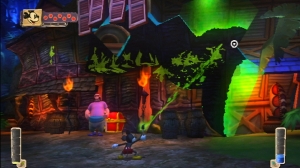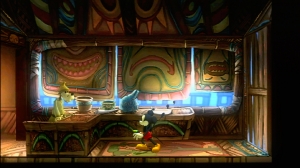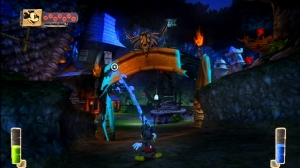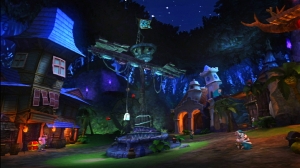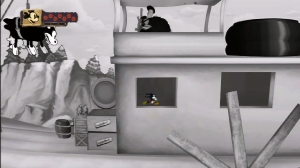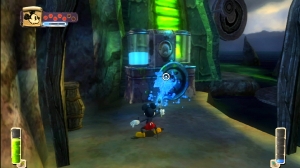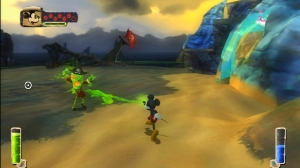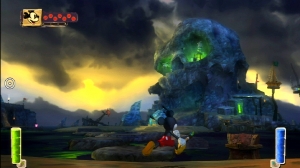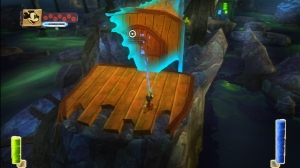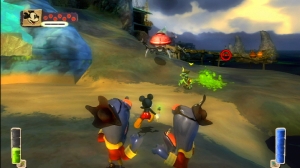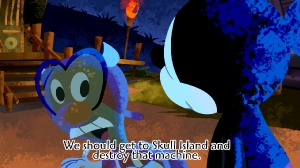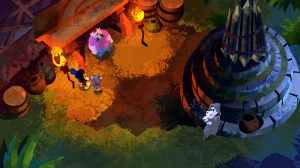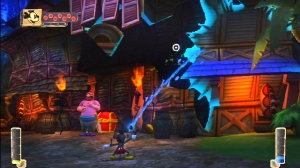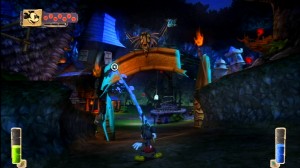 When a game comes out with a title that exudes greatness, you expect greatness. Epic Mickey from Disney Interactive Studios, is such a game. With “epic” in the title, you expect something that’s far superior, especially in comparison to a lot of the Nintendo Wii library of games, where good games are outnumbered by crappy games 3 to 1. What Epic Mickey ends up doing, is showing you the potential of a great game, without reaching said potential.
When a game comes out with a title that exudes greatness, you expect greatness. Epic Mickey from Disney Interactive Studios, is such a game. With “epic” in the title, you expect something that’s far superior, especially in comparison to a lot of the Nintendo Wii library of games, where good games are outnumbered by crappy games 3 to 1. What Epic Mickey ends up doing, is showing you the potential of a great game, without reaching said potential.
The story of Epic Mickey is one that bridges the history of Disney cartoon characters of the past and present, in a story that involves a forgotten world, where the characters of yesteryear reside, long forgotten by the audience they used to perform for. Replaced by the present batch of characters, Mickey and his friends. This is all slightly touched upon during gameplay, but the opening cinematic is where you get the gist of how the story begins. The wizard, Yen Sid, is making this world for the forgotten characters, dubbed Wasteland by its inhabitants. Mickey transports to the wizard’s workshop through a mirror, and sees Yen Sid making this world, with his magical paint brush. When Yen Sid is done, and leaves his workshop, Mickey decides to play around with the paint. What Mickey ends up doing is seemingly creating a horrible monster, which spilling paint and thinner on this world that the wizard had just made. Mickey, scared crapless, runs for the sanctuary of his room, through the mirror.
Time passes, and a history of Mickey’s cartoon exploits is briefly touched upon, as Mickey sleeps in his bed. Mickey is suddenly awakened by black gooey drops from his ceiling. A look of horror falls over Mickey’s face as the monster that was created by him in the wizard’s workshop is pulling him out of bed and back through the mirror. You then find Mickey strapped down in a mad scientist’s laboratory. This is where you start your adventure through the wasteland.
The object of the game, at its simplest form, is to save the Wasteland from the monsters that were created from the thinner disaster, which the inhabitants of Wasteland don’t realize was created by Mickey, and to get Mickey back home. This is all done by using your trusty paintbrush, which can shoot paint, or thinner.
Much of the game is played from an over the shoulder 3rd person view. There are several moments however, where the game goes into a 2D platformer mode, where your brush cannot be used. These moments are when you enter a house or office on certain worlds, and as a transitional level between the different main “worlds” of the game. It’s in these transitional 2D levels where you can gain a good amount of E-Tickets, which are basically in game currency. While the transitional 2D levels are fun, and give an awesome feel of the old black and white Mickey cartoons, they get quite repetitive when you need to travel back and forth between the same worlds.It’s almost as if the development team came in with wanting to do a 3D and a 2D game, and ended up combining the two, which isn’t bad, but isn’t great.
One of the problems with the 3rd person view is the camera. The camera can be moved with the D-Pad, reset into place with the C button on the nunchuck, and in some places you can press the 1 button, and enter a first person view, much in the way the first person view is done in Metroid: Other M, where you can look around, shoot your paint or thinner, but cannot move unless you get out of the first person view. Problem with the camera happen in high platforms on certain worlds, and in some places where you can’t even move the camera with the D-Pad. Sometimes you can’t even reset the camera, so that it’s stuck looking down from above you. While it’s a problem, it’s not a total game killer, though, you may have to get Mickey into odd positions on screen just to see what platforms you need to jump to next.
The cut scenes in this game are weird. While the opening cinematic is rendered in such a way that you’d almost expect to be treated to a whole movie, the cut scenes are done in a weird, almost stop-motion, gouache style, which comes really close to being out of place within the game. The cut scenes do their job, but are so few and far between that when you do get a cutscene, it slightly takes you out of the game. Another thing about the cutscenes, and the game on the whole, are the voices. Or rather, the lack of voices. While there are a lot of soundbytes and such that are used to represent certain characters, like Goofy’s “garsh” voicebyte, and Mickey’s “OH”, there is absolutely no talking other than in the opening, and as transitional movie clips after beating a boss. Instead of voices, what you get are subtitles, which a character stands there making motions indicating they are talking.
The paint and thinner concept is a unique one, because your use of each determines how you’re viewed by the populace of Wasteland. It’s like a constant choice of good and bad. Almost everything can be painted or thinned out. Thinning everything out is the “bad” way of doing things, painting everything is the “good” way. This is coupled with side quests that will also either endear you or alienate you to the people of Wasteland. In this respect, it’s a very unique good and evil mechanic that’s employed for the game.
An important thing about the side quests is that they’re not linear, a lot of the side quests depend on you having to backtrack through other worlds to complete them. This can sometimes become cumbersome, and even a little tedious. Thankfully, a good majority of the side quests are optional, but some have to be completed to continue on to the next world.
The soundtrack of the game is variant on which world you’re in, while the soundtracks of the 2D transitional levels is similar to that of old 1930s Mickey Mouse cartoons.To be honest, I didn’t really listen to the sounds of the game that much.
Overall, Epic Mickey is a good example of a game that makes good use of the Wiimote + Nunchuck controller configuration. There’s no awkwardness with this scheme, and makes use of the wiimote’s aiming abilities well. The camera can be a pain in certain situations, but can usually be put back on track if you just take a moment to move Mickey back into a neutral position on screen. Also, the nostalgia factor in this game is insane, especially on Mickeyjunk Mountain. Any fan of Disney cartoons should be all over this one, with its unlockable cartoons, and certain worlds resemblance to Disneyland or Disney World, it’s a fun lesson in a small section of Disney cartoon history.
Gameplay
Graphics
Sound
Overall
Buy Epic Mickey Online from EBGames.com for the Nintendo Wii

Click here to buy Epic Mickey Online for the Nintendo Wii from EBgames.com

